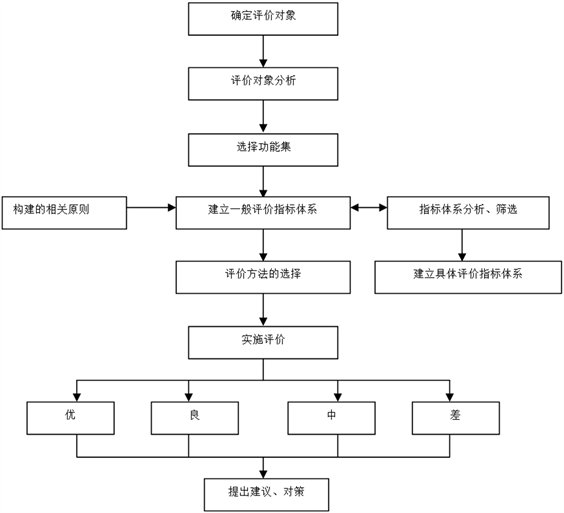1. 引言
我国高校机制体制改革一直是学界关注的热点问题之一。自新中国成立以来,我国高校管理体制经过了几次重大变革,与国外先进大学相比,我国高校的体制机制仍然存在许多的问题 [1] [2] [3] [4] [5] ,使我国高校在创新型人才培养和创新科研成果上与国外高校存在较大差距。为此,国家为加快实施创新驱动发展战略而推出的2011计划——高等学校创新能力提升计划为高校创新驱动机制的改革提供了思路和方向 [6] ,通过近3年的实施也取得了阶段性的成效,但仍然存在不少问题。例如,协同创新的体制机制改革不完善,管理行政化、学术垄断化等等 [7] [8] ,严重地阻碍了我国高校的进一步发展。
目前,国内学者对于高校体制机制改革方面的研究多集中在高校体制机制存在的问题与对策、改革方向与措施的探讨等方面 [9] [10] ,对高校绩效评价的研究也多集中在教师教学质量评价、科研项目评价方面,对高校改革绩效的评价,尤其是对2011计划的综合绩效评价研究甚少 [11] [12] 。因此,根据国家2011计划对高校体制机制协同创新的要求,如何科学、合理的评价高校协同创新的综合绩效是一个重要又有意义的问题。
2. 综合评价流程与内容
2.1. 评价流程
设计指标体系及进行综合评价是一项艰难的工作,在选择变量并加以综合的过程中,需要依据评价对象的实际情况进行确定,基于2011计划的高校体制机制协同创新绩效评价流程如图1所示。
2.2. 评价内容
高校管理是调节高校活动人、财、物等资源要素并指导全过程的行为,其主要目标是根据高校系统发展和创造知识同时直接或间接地为经济和社会服务的目标规范并指导高校的活动,以提升高校的创新能力、竞争力和效率。在高校管理中,体制机制的设立是高校科技活动能够良好地运行和开展的前提。在2011计划的倡导下,高校可以从管理制度改革、组织结构调整、基础设施建设、人才队伍建设、创新文化建设等方面着手,开展体制机制创新等尝试。同时,高等学校是一种多投入多产出的组织,通过投入多种教育资源从事教学、科研和服务活动,产生多种教育产出 [13] 。高校投入是其对人力、物力和财力资源投入的总和,包括教学设施、设备、房屋建筑、资金、人员等。高校的产出则主要包括人才培养产出、科研产出和社会服务与贡献方面的产出。

Figure 1. The performance evaluation process of the mechanism of collaborative innovation for university institutional based on the 2011 plan
图1. 基于2011计划的高校体制机制协同创新绩效绩效评价流程
高校体制机制改革是一个复杂的过程,对其改革的评价无疑也是一项复杂的、难度极大的工作。定量评价具有客观性、科学性的特点,但如果完全排除人的主观因素,反而会影响到评价结果的科学性。定性评价则可更全面的考虑问题,因统计数据而产生的片面和局限性可以获得缓解。但定性评价往往会受周围环境的影响而产生主观判断,从而造成评价结果的不稳定。因此,本研究更倾向于定性与定量方法相结合的评价方法,建立双重的综合的评价体系。在综合了国内外对高校体制机制改革评价的指标体系的基础上,本研究将评价指标按定量与定性指标进行分类,分别设为定量评价指标体系与定性评价指标两部分。其中,定量指标体系按投入、产出进行进一步细分,定性指标按管理制度改革、组织结构调整、基础设施建设、人才队伍建设、创新文化建设五个方面实施进一步细分。
3. 评价指标体系的构建
3.1. 构筑原则
1) 科学性与实用性相结合
具体指标的选取应建立在充分认识、系统研究的科学基础上。另一方面也必须注意资料的可取性,可操作性,尽可能选择那些有代表性的综合指标和重点指标。
2) 系统性与层次性相结合
通过对指标分类,将评价指标体系分解成若干子系统,明晰指标体系的结构,并应在不同层次上采用不同指标,避免指标的重叠。
3) 全面性与目的性相结合
全面性原则要求评价指标体系应反映高校运营管理的各个方面。同时,目的性原则要求指标的设计必须紧紧围绕着综合评价目的层层展开。
4) 可比性与监控性相结合
指标体系应既能反映同一高校在不同年份的水平变化程度,也能找出不同高校体制机制改革水平的差距。同时,指标体系应能反映出其中某一因素变化对高校综合绩效水平的影响,以便政府、高校决策者监控,督促并激励高校进一步改革的发展。
3.2. 评价指标的选取
通过专家组讨论法进行指标的筛选。让专家小组成员对于所研究的问题进行深入、广泛的讨论,并自由交换意见和观点,研究者依此进行归纳、分析、总结。选择相关的科研管理专家、科研人员,通过两轮专家讨论,对初建的绩效评价指标体系框架进行修订和完善,最终构建出基于2011计划的高校体制机制协同创新绩效评价体系(表1、表2)。

Table 1. The performance evaluation index system of the mechanism of collaborative innovation for university institutional based on the 2011 plan
表1. 基于2011计划的高校体制机制协同创新绩效定量评价指标体系

Table 2. The qualitative evaluation index of the mechanism of collaborative innovation for university institutional based on the 2011 plan
表2. 基于2011计划的高校体制机制协同创新绩效定性评价指标体系
3.3. 指标体系权重的设置
指标的权重是指每项指标对总目标实现的贡献的程度,反映各指标在评价对象中价值地位的系数。高校体制机制改革的评价体系是一个多层次、多目标系统,因此本文采用层次分析法(AHP)来确定指标的相对权重 [14] 。
经过计算,得出评价指标体系相对权重如表3、表4所示:

Table 3. The relative weight of quantitative evaluation index system of the mechanism of collaborative innovation for university based on the 2011 plan
表3. 基于2011计划的高校体制机制协同创新绩效定量评价指标体系相对权重表
Continued

Table 4. The relative weight of qualitative evaluation index system of the mechanism of collaborative innovation for university based on the 2011 plan
表4. 基于2011计划的高校体制机制协同创新绩效定性评价指标体系相对权重表
3.4. 指标方法的选择
绩效评价方法有很多种,如德尔斐法、平衡记分卡法、层次分析法、综合评价法及模糊综合评价法等等。
本研究中对定量指标的评价选用加权加法求和评价方法。按指标体系分为三个层次,一层一层进行计算。一般从三级指标层次开始,将三级指标的权重与收集的数据相乘可以获得三级指标加权值;然后,将属于同一个二级指标的所有三级指标加权值相加计算得出二级指标的数据值;接下来,将属于同一个一级指标的所有二级指标加权值相加计算出一级指标的数据值;最后将一级指标各值相加,得出最终综合评价值。
本研究对定性指标采用模糊综合评价方法 [15] 。对定性评价来说,其评价结果一个确定的数,往往是一个表达好坏程度的模糊概念。为了得到正确的评价结果,应该采用模糊综合评价方法。模糊综合评价法的应用非常广泛。其通过运用模糊数学和模糊统计方法,对事物的各个影响因素进行综合考虑,从而对被评价对象的好坏优劣做出科学地评价 [16] 。
4. 实证研究——以两型社会协同创新中心为例
4.1. 中心简介
中心以中南大学、湖南大学等为核心协同单位,湖南省两型办、湖南科技大学等为主要协同单位,中国有色金属工业协会、株洲市人民政府、中联重科等为支持与参与协同单位,于2012年6月13日正式签署共建合作协议。按照“以机制体制改革引领协同创新,以协同创新引领高等学校创新能力的全面提升”的要求,以组织管理体制改革为基础,以人事制度改革为核心,以科研成果转化为关键,以人才培养机制改革和科研组织模式创新为支撑,以资源配置方式、国际合作和文化理念创新为保障,构建全方位的协同创新制度体系,提升中心在人才、学科、科研方面“三位一体”的协同创新能力和国际水平,带动高校机制体制改革,为我国两型社会与生态文明建设提供持续的创新动力和保障。
4.2. 综合绩效评价
通过对两型中心近年来的数据进行收集与分析,得到对定量指标各项指标在改革前后的数据如表5。

Table 5. The evaluation index score system
表5. 评价指标体系评分表
Continued
根据上述评价指标体系及指标权重分别计算两型社会协同中心在改革前与改革后的综合评价值。
定量评价指标体系的综合评价值计算如下:
改革前:
改革后:
对定性指标进行模糊综合评价如下:
(1) 采用专家打分法获得定性指标评语集
邀请专家根据定性指标评价等级标准(如表4),对两型社会协同创新中心改革情况进行打分,采用百分制统计法统计专家意见。
例如,邀请20位专家对“健全人事管理制度G1”进行等级评价,没有专家认为人事管理制度健全为“好”和“较好”,则“好”与“较好”对隶属度为0;有10位认为人事管理制度“一般”,除以专家总数后得到“一般”的隶属度为0.5;有8位专家认为“较差”,则“较差”对隶属度“0.4”;有2位专家认为人事管理制度为“差”,“差”的隶属度“0.1”,汇总得到G1的模糊评价矩阵为[000.50.40.1]。
根据专家的评分结果,进行统计得出两型中心改革前后评价结果分别为表6、表7。

Table 6. The fuzzy comprehensive evaluation matrix before reform
表6. 改革前模糊综合评价矩阵

Table 7. The fuzzy comprehensive evaluation matrix after reform
表7. 改革后模糊综合评价矩阵
经计算:
改革前最终结果B = [0, 0.24988, 0.50519, 0.24493, 0]
改革后最终结果B = [0.276215, 0.426165, 0.29762, 0, 0]
根据最大隶属度原则,从定性评价角度,两型社会协同创新中心改革前隶属于一般,改革后隶属于较好,评价结果显示绩效有所提升。
5. 结论
由评价结果可知,两型社会协同创新中心改革前绩效评价结果不论是从定量评价,还是定性评价结果看,最终绩效水平均有提升,显示改革措施有所成效。从案例分析的结果来看,高校在国家2011计划的倡导下,开展协同创新模式,转变以往的体制机制管理模式,实施更为高效的管理体制以后,确实能带来资源利用效率的提升和管理绩效的提高,增强自身的竞争能力和创新能力。
致谢
感谢杨青月、曾雨滴的整理协助。
基金项目
2016年湖南省普通高等学校教学改革研究项目、2016年中南大学教育教学改革研究项目:高校“学生–学术–学科”三位一体综合评价体系构建研究——基于省2011计划视角(项目编号:2016jy53)。